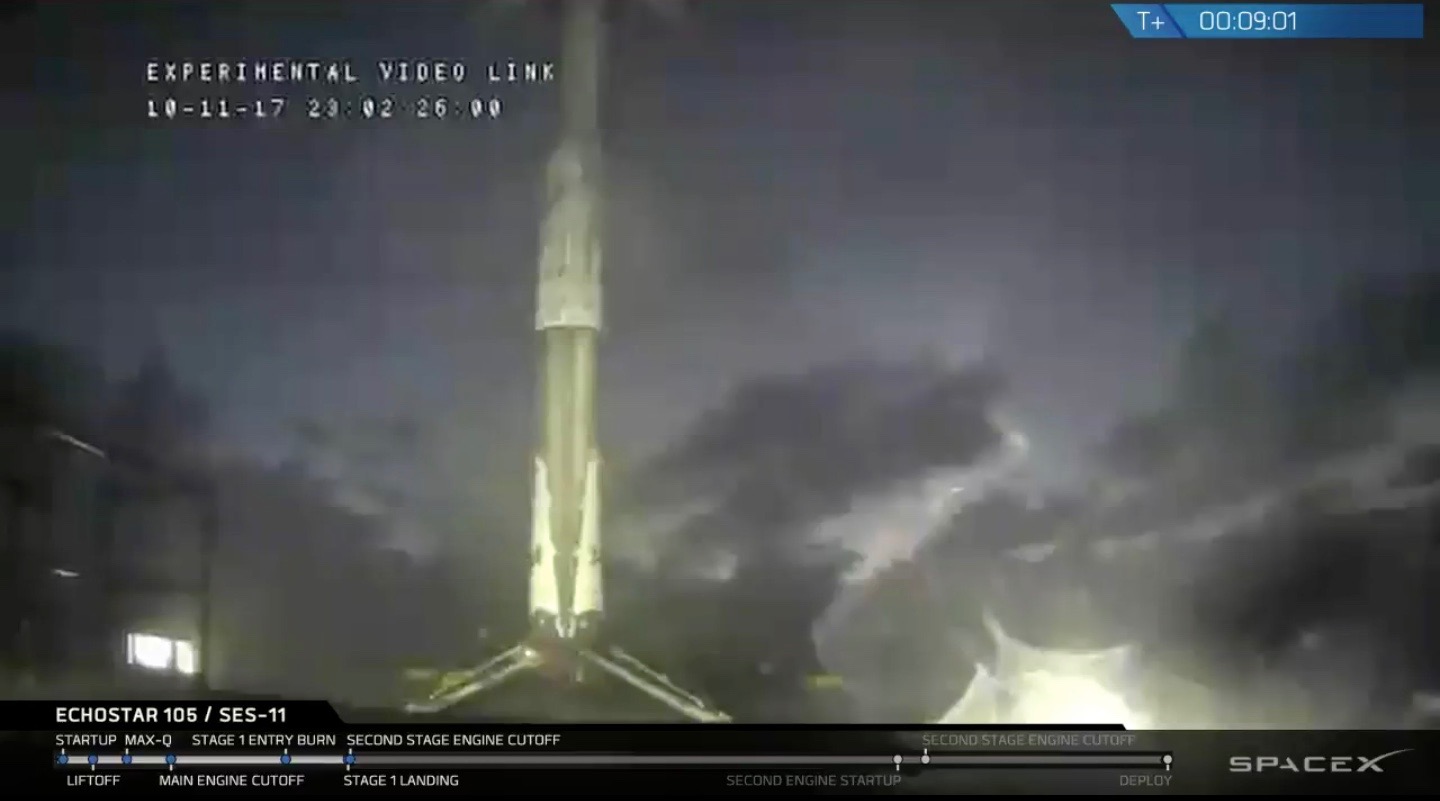That Makes Three: SpaceX Launches Another Satellite with a Used Rocket, Then Lands
SpaceX is really putting its reusable-rockets vision into action.
A two-stage Falcon 9 booster with a pre-flown first stage successfully launched the EchoStar 105/SES-11 communications satellite to orbit today (Oct. 11), marking the third time SpaceX has pulled off such a used-rocket feat.
The Falcon 9 lifted off at 6:53 p.m. EDT (2253 GMT) from historic Pad 39A at NASA's Kennedy Space Center in Florida. About 8.5 minutes later, the first stage came back to Earth for a pinpoint landing on the robotic SpaceX ship named "Of Course I Still Love You," which was stationed in the Atlantic Ocean. It was the second successful mission in three days for SpaceX. [The Rockets and Spaceships of SpaceX]
This was the booster's second successful landing; the first came on Feb. 19, when the rocket stage helped send SpaceX's Dragon cargo capsule on an uncrewed resupply run to the International Space Station (ISS) for NASA. (That February launch, by the way, was SpaceX's first from Pad 39A, which previously hosted liftoffs for NASA's Apollo and space shuttle programs.)
SpaceX now has a total of 18 Falcon 9 first-stage touchdowns under its belt. The California-based company first re-flew one of those landed boosters on March 30, during the launch of the SES-10 communications satellite. Another launch helped loft the BulgariaSat-1 spacecraft on June 23.
Also in June, SpaceX successfully flew a used Dragon capsule on an ISS cargo mission.
These activities are part of the company's effort to develop fully and rapidly reusable rockets and space vehicles. Such technology will slash the cost of spaceflight, helping open the heavens to exploration, SpaceX founder and CEO Elon Musk has said. Indeed, reusability is key to Musk's vision for Mars colonization, the latest iteration of which he unveiled late last month at a conference in Australia.
Get the Space.com Newsletter
Breaking space news, the latest updates on rocket launches, skywatching events and more!

With all of that said, the main goal of today's mission was getting EchoStar 105/SES-11 aloft. And that did indeed happen; the Falcon 9's second stage deployed the satellite into its planned geostationary transfer orbit 36 minutes after liftoff.
"And there it is!" said SpaceX firmware engineer Tom Praderio, who provided commentary during the company's launch webcast today. "You can see the EchoStar 105/SES-11 satellite successfully deployed from the top of the Falcon 9 second stage, gliding away into space."
As its name suggests, EchoStar 105/SES-11 will be used by both the Colorado-based operator EchoStar and the Luxembourg company SES. The satellite will provide high-definition TV service throughout North America, the Caribbean and Hawaii, according to a SpaceX press kit.
Today's successful launch and landing marked the second such double play for SpaceX in the span of three days. On Monday (Oct. 9), a Falcon 9 launched 10 satellites for the communications company Iridium from Vandenberg Air Force Base in California. That rocket's first stage (which was brand-new) also aced a drone-ship landing.
Space.com senior producer Steve Spaleta contributed to this report.
Follow Mike Wall on Twitter @michaeldwall and Google+. Follow us @Spacedotcom, Facebook or Google+. Originally published on Space.com.
Join our Space Forums to keep talking space on the latest missions, night sky and more! And if you have a news tip, correction or comment, let us know at: community@space.com.

Michael Wall is a Senior Space Writer with Space.com and joined the team in 2010. He primarily covers exoplanets, spaceflight and military space, but has been known to dabble in the space art beat. His book about the search for alien life, "Out There," was published on Nov. 13, 2018. Before becoming a science writer, Michael worked as a herpetologist and wildlife biologist. He has a Ph.D. in evolutionary biology from the University of Sydney, Australia, a bachelor's degree from the University of Arizona, and a graduate certificate in science writing from the University of California, Santa Cruz. To find out what his latest project is, you can follow Michael on Twitter.









